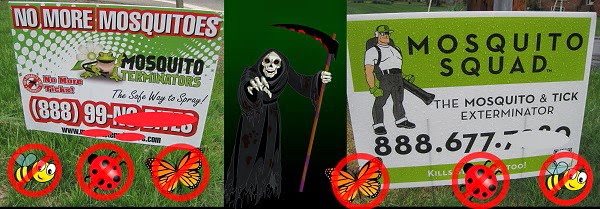Effective, safe mosquito control requires more brains than brawn
 |
| Yard signs from mosquito control companies. [photo by Friends of Accotink Creek] |
By Elizabeth Kirchner
A yard sign advertisement shows a muscular cartoon warrior wielding a backpack sprayer blasting a towering spear-stingered mosquito: Insecticide “fogging” to control mosquitoes in summertime backyards seems powerful and effective, but specialists—even representatives of insect-control industries, Fairfax County, and the CDC—say misting systems are temporary at best, damaging at worst, and real mosquito control requires a smart, integrated approach that reaches beyond your azaleas.
On a sultry night in the jungles of Annandale, few things says ”summer” more than that maniacal whine and a sharp slap on a naked neck. Mosquitoes are annoying and, although transmission rates are low, the Culex species that live in Northern Virginia are vectors of diseases like West Nile virus (but not malaria or dengue fever).
As tempting as it may be, drenching the vampiric beasts rising out of your bushes in a cloud of poison is the neck slap—the oaf, the Neanderthal—of mosquito-control. Most misting strategies are aimed at adult mosquitoes, not their larvae.
Caught in the cross fire are mosquito predators and all the other beneficial animals, like pollinators, birds, and butterflies, that live in your yard with you.
Fairfax County bulletins point out the toxicity differences of insecticides and the surprising differences in their targets: Bifenthrin, a plant-derived pyrethroid and the active agent in Ortho’s Home Defense, Astro, and Dragnet which are used by some local commercial mosquito-control companies, are “non-toxic in humans and animals, moderately toxic to many bird species, but toxic to most aquatic species, and very toxic to bees.” Bifenthrin is used on dogs, but is described as “exquisitely” toxic to cats.
Improperly targeted insecticide use, the kind that happens without first monitoring to determine mosquito population levels or maturity, contributes to insecticide resistance. Culex mosquitoes are increasingly resistant to these widely used pyrethroids.
The American Mosquito Control Association, a nonprofit organization representing the insect-control industry and researchers that describes its mission as the “enhancement of public health and quality of life through the suppression of mosquitoes,” advises a smarter, more finessed approach.
“Know your enemy,” the association urges. Chemical control measures are “just one part of a comprehensive and integrated mosquito management program.” And an integrated program is the most effective way to prevent mosquito-borne disease.
These 10 cultural practices—in your yard and beyond—will help:
• The most effective and least expensive way to control mosquitoes is to stop raising them. Get rid of all standing water on your property. Mosquitoes, active at dawn and dusk, are sluggish fliers. If you’re being chewed on, they’re breeding nearby.
• So, eliminate or treat the standing water where mosquitoes lay their eggs and their larvae grow. Turn over or remove containers in your yard where water collects—as little as a tablespoon—in potted plant trays, buckets, toys, wheelbarrows, tarps, and tires.
• Use mesh over rain barrels.
• Use Bacilus thuringiensis (Bt), a biocontrol that’s an ingredient in Dunks, in ornamental water features or add fish and a fountain. Bt resistance has already been seen in Culex species in California, though.
• Clean bird baths.
• Clean roof gutters to keep water flowing freely
• Drain downspouts. Be sure that the ribbed flexible plastic pipes used for downspout drainage are installed so that water drains from the grooves.
• Wear light clothing with long sleeves and trousers in the evening and morning. It’s elegant.
• Attract natural predators like bats and birds. Although they’re not selective, they will eat mosquitoes.
• Protect a healthy greenspace. Trees support mosquito predators. Amphibians like salamanders live in upland forests and under the trees in your yard. Adult amphibians come out of the leaf litter on warm stormy early spring nights to breed in vernal pools where they nosh on mosquito larvae.
• Protect healthy waterways. Dragonfly nymphs are mosquito predators. They live in waterways like Accotink Creek and are susceptible to poor water quality. Some towns in Maine buy and release dragonfly nymphs in local waters to help keep local mosquito populations under control.


Thank you for this informative post. As a beekeeper in Annandale, seeing those mosquito fogger ads make me want to cry. It's yet another stressor in their uphill fight to survive in an environment we've radically changed.
Beekeeper in Annandale? Do you produce any local honey? I hear it's great for allergies.
Beekeeper in Annandale? Do you produce local honey?
I"m trying, we're in our second year and should get at least few jars. This winter was rough (one in four hives were lost nationwide) but we made it through! If you're looking for local honey there's a fellow selling in the summer at the Falls Church farmers' market.
I miss local Annandale honey. I used to buy honey from Mr.Cook at the farmers market.